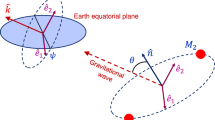Abstract
An explicit equation of the propagational angle of microwave emission between the line-of-sight and the local magnetic field is newly derived based on the approximated formulae of nonthermal gyrosynchrotron emission (Dulk and Marsh in Astrophys. J. 259, 350, 1982). The existence of the solution of propagational angle is clearly shown under a series of typical parameters in solar microwave observations. It could be used to determine the intrinsic mode and linear mode coupling in solar microwave bursts by three steps. (1) The mode coupling may happen only when the angle approximately equals to 90 degrees, i.e., when the emission propagates through the quasi-transverse region (Cohen in Astrophys. J. 131, 664, 1960). (2) The inversion of polarization sense due to the weakly mode coupling takes place only when the transition frequency defined by Cohen (1960) is larger than the frequency of microwave emission, and an observable criterion of the weakly mode coupling in flaring loops was indicated by the same polarization sense in the two footpoints of a flaring loop (Melrose and Robinson in Proc. Astron. Soc. Aust. 11, 16, 1994). (3) Finally, the intrinsic mode of microwave emission is determined by the observed polarization and the calculated direction of local magnetic field according to the general plasma dispersion relation, together with the mode coupling process. However, a 180-degree ambiguity still exists in the direction of longitudinal magnetic field, to produce an uncertainty of the intrinsic mode. One example is selected to check the feasibility of the method in the 2001 September 25 event with a loop-like structure nearby the central meridian passage observed by Nobeyama Radio Heliograph and Polarimeters. The calculated angle in one footpoint (FP) varied around 90∘ in two time intervals of the maximum phase, which gives a direct evidence of the emission propagating through a quasi-transverse region where the linear mode coupling took place, while, the angle in another FP was always smaller than 90∘ where the mode coupling did not happen. Moreover, the right-circular sense at 17 GHz was always observed in both two FPs during the event, which supports that the transition frequency should be larger than 17 GHz in the first FP together with strong magnetic field of over 2000 Gauses in photosphere, where the weakly coupled case should happen. Moreover, there are two possibilities of the intrinsic mode in the two FPs due to the 180-degree ambiguity. (1) The emission of extraordinary (X) mode from the first FP turns to the ordinary (O) mode in the two time intervals of the maximum phase, while, the X-mode is always emitted from the second FP. (2) The inversion from O-mode to X-mode takes place in the first FP, while the O-mode keeps in the second FP. If the magnetic polarities in photosphere and corona are coincident in this event, the intrinsic mode belongs to the second case.



Similar content being viewed by others
References
Alissandrakis, C.E., Nindos, A., Kundu, M.R.: Sol. Phys. 147, 343 (1993)
Altyntsev, A.T., Fleishman, G.D., Huang, G.L., Melnikov, V.F.: Astrophys. J. 677, 1367 (2008)
Cohen, M.H.: Astrophys. J. 131, 664 (1960)
Dulk, G.A.: Annu. Rev. Astron. Astrophys. 23, 169 (1985)
Dulk, G.A., Marsh, K.A.: Astrophys. J. 259, 350 (1982)
Gopalswamy, N., Zheleznyakov, V.V., White, S.M., Kundu, M.R.: Sol. Phys. 155, 339 (1994)
Huang, G.L.: Sol. Phys. 237, 173 (2006)
Huang, G.L., Lin, J.: Astrophys. J. 639, L99 (2006)
Huang, G.L., Nakajima, H.: Astrophys. J. 696, 136 (2009a)
Huang, G.L., Nakajima, H.: Astrophys. J. 702, 19 (2009b)
Huang, G.L., Song, Q.W., Nakajima, H.: Astrophys. J. 723, 1806 (2010)
Kundu, M.R., Nitta, N., Shibasaki, K., Enome, S., Sakao, T., Kosugi, T., Sakurai, T.: Astrophys. J. 454, 522 (1995)
Kundu, M.R., White, S.M., Shibasaki, K., Sakurai, T., Grechnev, V.V.: Astrophys. J. 547, 1090 (2001)
Ledenev, V.G., Tirsky, V.V., Tomozov, V.M., Zlobec, P.: Astron. Astrophys. 392, 1089 (2002)
Mclean, D.J., Sheridan, K.V.: Sol. Phys. 26, 176 (1972)
Melrose, D.B., Robinson, P.A.: Proc. Astron. Soc. Aust. 11, 16 (1994)
Nita, G.M., Gary, D.E., Lee, J.: Astrophys. J. 605, 528 (2004)
Peterova, N.G., Akhmedov, Sh.B.: Sov. Astron. 17, 768 (1974)
Preka-Papadema, P., Alissandrakis, C.E.: Astron. Astrophys. 191, 365 (1988)
Ramaty, R.: Astrophys. J. 158, 753 (1969)
Su, Y.N., Huang, G.L.: Sol. Phys. 219, 159 (2004)
Takakura, T., Scalise, E.: Sol. Phys. 11, 434 (1970)
Vourlidas, A., Bastian, T.S., Aschwanden, M.J.: Astrophys. J. 489, 403 (1997)
White, S.M., Thejappa, G., Kundu, M.R.: Sol. Phys. 138, 163 (1992)
Zheleznyakov, V.V., Kocharovsky, V.V., Kocharovsky, Vl.V.: Astron. Astrophys. 308, 685 (1996)
Zhou, A.H., Karlický, M.: Sol. Phys. 153, 441 (1994)
Acknowledgements
The study is supported by two NFSC projects respectively with No. 11073058 and 10833007, as well as the “973” program with No. 2011CB811402. The authors would like to thank the NoRH teams for their dedicated data preparing and preprocessing.
Author information
Authors and Affiliations
Corresponding author
Rights and permissions
About this article
Cite this article
Huang, G., Song, Q. & Li, J. Determination of intrinsic mode and linear mode coupling in solar microwave bursts. Astrophys Space Sci 345, 41–47 (2013). https://doi.org/10.1007/s10509-013-1372-y
Received:
Accepted:
Published:
Issue Date:
DOI: https://doi.org/10.1007/s10509-013-1372-y




